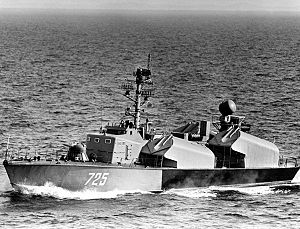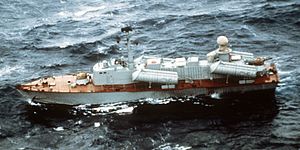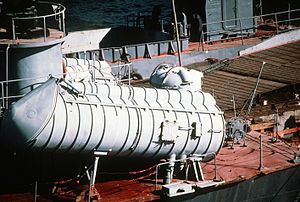- Osa class missile boat
-

Osa I (Project 205) craftClass overview Name: Osa (Project 205) Operators: see below Preceded by: Komar class missile boat Succeeded by: Tarantul class corvette Subclasses: Osa I, Osa II Completed: 400+ General characteristics Type: Fast attack craft Displacement: 171.5 tons standard, 209 tons full load Length: 38.6 m Beam: 7.64 m Draught: 3.8 m Installed power: - 3x 4000 hp M-503G diesel engines (205)
- 3x 5000 hp M-504B diesel engines (205U onwards)
Propulsion: 3 shafts Speed: - 38.5 knots (205)
- 42 knots (205U onwards)
Range: 1,800 nmi (3,300 km) at 14 knots,
800 nmi (1,500 km) at 30 knots,
500 nmi (930 km) at 35 knotsEndurance: 5 days Complement: - 28 (Osa I)
- 29 (Osa II)
Sensors and
processing systems:- MR-331 Rangout (Square Tie) radar
- Klyon fire-control system for P-15 Termit
- Nickel IFF
- MR-104 Rys (Drum Tilt) fire-control radar for AK-230
- ARP-58SV radio direction finder
Electronic warfare
and decoys:- Nikhrom-RRM IFF/ESM
Armament: - 2x AK-230 twin 30 mm CIWS
- 4x P-15 Termit (SS-N-2 Styx) anti-ship missiles
The Project 205 Tsunami[1], more commonly known by their NATO reporting name Osa, are a class of missile boats developed for the Soviet Navy in the early 1960s. The Osas are probably the most numerous class of missile boats ever built, with over 400 vessels constructed for both the Soviet Navy and for export to allied countries. "Osa" means "wasp" in Russian, but it is not an official name. The boats were designated as "large missile cutters" in the Soviet Navy.
Contents
Origins
While the earlier Komars were cheap and efficient boats (and the first to sink a warship with guided missiles, destroying the Israeli Navy's Eilat), their endurance, sea keeping, and habitability were modest at best, and the missile box was vulnerable to damage from waves. Among their other weak points were the wooden hull, the radar set lacking a fire control unit, and an inadequate defensive armament consisting of two manually operated 25 mm guns with only a simple optical sight in a single turret. The Komars' offensive weapons were a pair of P-15 Termit (NATO: SS-N-2 "Styx") missiles, and there insufficient capacity to hold the more recent longer-ranged P-15Ms. The sensors were not effective enough to use the maximum range of the missiles, and the crew of 17 was not large enough to employ all the systems efficiently.
As a result of these well recognized shortcomings, Komars were organized in squadrons of six units, because it was expected that every NATO destroyer needed two missile hits to be sunk and this could only be assured with 12 missiles. Since Komars were rated with a rather low survivability, it was necessary to use three squadrons for every target to ensure success. In order to remedy all these shortcomings, it was felt that bigger boats were needed to mount the necessary equipment and to provide more space for a larger crew.
Project
The Project 205 boats are bigger than the pioneering Project 183R (NATO: Komar class) boats, with a mass four times greater, and nearly double the crew. They were still meant to be 'minimal' ships for the planned tasks.
The hull was made of steel, with a low and wide superstructure made of lighter AMG alloys, continuous deck, and a high free-board. The edges of the deck were rounded and smooth to ease washing off radioactive contamination in case of nuclear war. The hull was quite wide, but the Project 205 boats could still achieve high speeds as they had three Zvezda M503 radial diesel engines capable of a combined 12,000 hp (15,000 hp on Project 205U onward) driving three shafts. The powerful engines allowed a maximum speed of about 40 knots (with 60 hp/ton, three times that of a 'fast tank' like Leopard 1) together with reasonable endurance and reliability. There were also three diesel generators. Two main engines and one generator were placed in the forward engine room, the third main engine and two generators in the aft engine room. There was a control compartment between the two engine rooms.
The problem related to the weak anti-aircraft weaponry of the earlier Project 183R was partially solved with the use of two AK-230 turrets, in the fore and aft deck. An MR-104 Rys (NATO: "Drum Tilt") fire-control radar was placed in a high platform, and controlled the whole horizon, despite the superstructures that were quite wide but low. Even if placed in the aft, this radar had a good field of view all around. The AK-230 turrets were unmanned, each armed with two 30 mm guns capable of firing 2,000 rpm (400 practical) with a 2,500 m practical range. Use against surface targets was possible, but as with the previous Komar ships, once all missiles were expended it was planned to escape and not fight. Truly effective anti-surface weaponry was not available until the introduction of the Project 12341.1 Molniya (NATO: "Tarantul") class corvettes, with 76 mm guns.
The missile armament consisted of four box-shaped launchers (protected from bad weather conditions) each with one P-15 Termit (NATO: SS-N-2 "Styx") missile. This doubled the available weapons compared to the Project 183R, giving greater endurance. The missiles were controlled by a MR-331 Rangout (NATO: "Square Tie") radar and a Nikhrom-RRM ESM/IFF that even allowed targeting over the horizon, if the target's radar was turned on.
With all these improvements, these ships were considerably more effective. They had one of the first, if not the first close-in weapon systems (CIWS). The survivability rating was improved to 50%, and the required volley of 12 missiles could be launched by only three ships. Sinking a destroyer was therefore regarded as 'assured' using only six ships (two squadrons of three vessels), making the Project 205 vessels easier to coordinate and even cheaper than would be the required number of Project 183R boats to achieve the same effectiveness.
As a result of these improvements, Project 205 boats were without equal in the late 1950/early 1960s. Over 400 were made in USSR, and another 120 in China. Some of the improved Project 205U (Osa II) were equipped with the 9K32 Strela-2 (NATO: SA-N-5 "Grail") surface-to-air missiles in MTU-4 quadruple launchers, in an attempt to improve air-defences. This new model also had improved, more powerful engines, and new cylindrical missile boxes, with the improved P-15U missiles. The later 205M and 205mod boats had longer tubes for the further-improved P-15M missiles.
Variants
The Project 205's hull proved to be very versatile and were used as the basis for a whole series of Soviet fast attack craft and patrol boats.
- Project 205 ("Osa I"): Original missile boat, recognisable by the box-shaped missile launchers for the P-15/P-15T Termit missiles. 160 built.
- Project 205E: Project 205 with 4 KT-62K missile launchers for P-25 missiles and a forward hydroplane, making it capable of reaching up to 50 kn (93 km/h). 1 built.
- Project 205Ch: Project 205 with electric equipment on 400 Hz. 1 built.
- Project 205U ("Osa II"): Upgraded Project 205 with tube-shaped missile launchers for the improved P-15U missile. 32 built.
- Project 205ER: Main export version of the Project 205U. Nikhrom-RRM IFF/ESM, Nickel IFF, and ARP-58SV radio direction finder removed.
- Project 205M: Longer missile tubes for P-15M missiles with new Graviy radar complex instead of Rangout/Rys complex. 1 built.
- Project 205mod: P-15M missile instead of P-15U. 19 built.
- Project 205P Tarantul ("Stenka"): Anti-submarine patrol boat version.
In addition to the above, the Project 206 family of fast attack craft (NATO: Shershen, Turya, and Matka class) are based on the Project 205 and share a common engine room design.
Combat service
These missile boats saw action during the Six Day War, Yom Kippur War, and Indo-Pakistani War of 1971. The Israelis sank an Osa class Syrian boat during the Battle of Latakia, while the Indian Navy, in contrast, was quite successful against the Pakistani Navy in its Operation Trident (Indo-Pakistani War). Osas were also used in the Iraq-Iran War, with many losses, especially in a single battle in 1980 when several were destroyed by F-4s with AGM-65s. This battle occurred on 29 November 1980[2] and the Iraqi Navy incurred heavy damage.
Syrian Osa II's have been used in the 2011 Syrian Uprising. Osa II's were filmed firing their deck guns into the city of Latakia.[3]
The shortcomings that the Osas had were mainly the low efficiency of their missiles against small and ECM-equipped targets, as seen in Battle of Latakia. In this conflict, Osas and Komars fired first, thanks to the longer range of missiles and favourable radar propagation conditions, but missed the targets, and were not capable of escaping due to some engine malfunctions. The lack of medium caliber gun hampered defence against gunboats, even though the USSR had 37, 45 and 57 mm guns capable of being fitted in place of one 30 mm gun, as happened in some other vessels, such as the Poti ASW corvettes. Effective anti-missile systems were never equipped even though there was no significant size or weight difference between the AK-230 and the AK-630 CIWS.
The successor was the Project 1241 Tarantul class corvette, with twice the displacement and a higher cost, but still armed with only four P-15s. They finally had a better electronic suite and a 76 mm gun with high rate of fire. CIWS and 'Bass Tilt' radar were fitted, and at one time they were equipped with Moskit supersonic missiles. Few were built, however, and so the Osas, after replacing the old Komars, remained widely in service, until recent years.
Operators
About 175 Osa I and 114 Osa II boats were built for the Soviet Navy, the last were decommissioned in about 1990 in the main Soviet fleet. Amongst the post-Soviet countries, one boat is in service with the Azerbaijan Navy and two are in service with the Latvian Navy.
Osa I
 Benin
Benin- Military of Benin −2 boats in 1979
 Bangladesh
Bangladesh- Bangladesh Navy – 5 boats
 Croatia
Croatia- Croatian navy – 1 boat, decommissioned during the 1990s.
 China
China- People's Liberation Army Navy – 4 boats in early 1960s plus over 120 license-produced.
 Egypt
Egypt- Egyptian Navy – 4 OSA-I remaining from 10 delivered by the Soviet Union in the 1970s + 5 OSA-I bought from Serbia and Montenegro in 2007.
 East Germany
East Germany- East German Navy – 15 boats transferred 1962–1971 – decommissioned 1981–1990
 India
India- Indian Navy – 8 boats transferred in 1971 – decommissioned 1982–1990
 Latvia
Latvia- Latvian Navy – 6 ex-East German boats, decommissioned during 1990s.
 Montenegro
Montenegro- Military of Montenegro
 North Korea
North Korea- North Korean Navy – 12 boats transferred 1968–73
 Poland
Poland- Polish Navy – 13 boats transferred 1964–1975 – decommissioned 1984–2006
 Romania
Romania- Romanian Navy – 6 boats in service 1964–2004
 Soviet Union
Soviet Union- Soviet Navy – Passed on to successor states
 Syria
Syria- Syrian Navy – 8 boats
 Yugoslavia
Yugoslavia- Yugoslav Navy – 10 boats
Osa II
 Algeria
Algeria- Algerian Navy – 8 boats transferred 1978
 Angola
Angola- Angolan Navy – 6 boats transferred 1982–83
 Azerbaijan
Azerbaijan- Azerbaijani Navy – 1 boat
 Bulgaria
Bulgaria- Bulgarian Navy – 3 boats
 Cuba
Cuba- Cuban Navy – 13 boats
 Egypt
Egypt- Egyptian Navy – 4 boats (See note fom Finland's Tuima class missile boat)
 Eritrea
Eritrea- Eritrean Navy 5 boats
 Finland
Finland- Finnish Navy – 4 boats transferred 1974–75. Known as Tuima class missile boats. Decommissioned in 2003 and sold to Egyptian Navy, to be used as Minelaying boats after being retrofitted.
 India
India- Indian Navy – 8 boats transferred 1976–77, decommissioned 1999–2003
 Libya
Libya- Libyan Navy – Unknown
 Libyan Republic
Libyan Republic- Libyan People's Army – Unknown
 Russia
Russia- Russian Navy – Passed on from Soviet Navy
 Somalia
Somalia- (Somaliland) Military of Somaliland – 2 boats
 Soviet Union
Soviet Union- Soviet Navy – Passed on to successor states
 Syria
Syria- Syrian Navy- 12 boats
 Vietnam
Vietnam- Vietnamese Navy – 8 boats
 Yemen
Yemen- Yemen Navy – 18 boats
References
- Conway's All the World's Fighting Ships 1946–1995
- Page on Osa 2 from Indian Navy history
- Page on Osa 1 from Indian Navy history
- Trident and other operations in 1971 Indo-Pakistan war
- Slade, Stuart, The true history of Soviet anti-ship missiles, RID magazine, May 1994.
- Shikavthecenko, V, 'Lightings in the sea: the Russian FACs developments' RID September 1995.
- ^ Russian: Проект 205 «Цунами»
- ^ Arabian Peninsula & Persian Gulf Database
- ^ http://english.aljazeera.net/news/middleeast/2011/08/201181475734965763.html
Soviet Navy and Russian Navy ship classes after World War IIAircraft carriers Moskva · OREL1 · Kiev · Ulyanovsk1 · Admiral Kuznetsov
Battlecruisers Stalingrad 1 · Kirov
Cruisers Destroyers Skoryy · Neustrashimy · Kotlin · Kildin · Krupny · Kanin · Kashin · Sovremenny · Udaloy · Project 21956
Frigates Kola · Riga · Petya · Mirka · Koni · Burevestnik · Gepard · Neustrashimy · Novik · Admiral Sergey Gorshkov · Admiral Grigorovich
Corvettes P / M / T boats Minesweepers Amphibious ships Patrol icebreakers Other vessels 1 Cancelled.
2 To be purchased.Categories:- Missile boat classes
- Missile boats of the Soviet Navy
- Missile boats of the Algerian National Navy
- Missile boats of the Angolan Navy
- Missile boats of the Azerbaijani Navy
- Missile boats of the Bangladesh Navy
- Missile boats of the Benin Navy
- Missile boats of the Bulgarian Navy
- Missile boats of the Croatian Navy
- Missile boats of the Cuban Navy
- Missile boats of the Egyptian Navy
- Missile boats of the Eritrean Navy
- Missile boats of the Korean People's Navy
- Missile boats of the Latvian Naval Forces
- Missile boats of the Libyan Navy
- Missile boats of the Montenegro Navy
- Missile boats of the People's Liberation Army Navy
- Missile boats of the Polish Navy
- Missile boats of the Romanian Naval Forces
- Missile boats of the SFR Yugoslav Navy
- Missile boats of the Somali Navy
- Missile boats of the South Yemen Navy
- Missile boats of the Syrian Navy
- Missile boats of the Vietnamese People's Navy
- Missile boats of the Volksmarine
Wikimedia Foundation. 2010.


